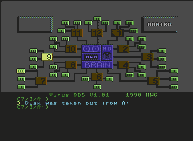Get a life is a game of Teonaki. In this game you're a virus and you have to kill a mainframe using some sort of VOS ("Virus Operating System") from command line.
The idea of this game was born in Teonaki's head, he wanted to create a game in which the player would play the role of a deadly computer virus. In those days encounters with viruses were pretty common things. The game took third prize as well in a contest.
I don't remember exactly the game play. In the upper part of the screen a schematic map of a computer network was displayed, with some terminals and a main frame. The object of the game was to kill the main frame through infecting machines. There was a central virus killer that removed infection from machines. It was a really nice real-time game.
The lower part was some sort of a console. The player was able to execute commands to control the virus, to infect different parts of the network. The commands were interpreted and executed or denied by the Virus Operating System.
The commands I was able to decipher:
- cls: Clear screen
- quit: Give up
- ver: Display version info
- dir: Display disk information of drive
- a: / c: (only on consoles): change drive
- c1 - c12: change console
- 1 / 2 / 3: change local board
- cxx/y: change console and board at the same time
- I was able to discover some other command fragments, but was unable to use them properly: brain, tape, hico ?, hide ?, track. I have absolutely no idea how you can infect disks, machines, etc.
Download
- Full Version: The full version of Get a Life. (174 848 bytes)
Autoloader, start with LOAD":*",8,8
Music
- Intro Theme 2426 KBytes, MP3, 44.1 kHz, 16 bit, 96 KBps, Mono
- Hall of Fame Theme 2653 KBytes, MP3, 44.1 kHz, 16 bit, 96 KBps, Mono
All screen shots presented here contain the whole screen area (or even more), the borders are always included. Of course there're some border take-offs... Captured using CCS64 and its Use PAL Palette mode.




2 comments:
Get a Life
1.0 (beta)
You have to disconnect as many "Boards" and "Comps" from the net as you can. Race against an AV software checking all nodes periodically.
If you manage to get on the tape drive there's a chance that you will be loaded in to the Brain and you can kill the whole system.
It took the 3rd place because it was seen by the judges as unethical (LOL) to write a game about infecting computers with viruses.
Commands:
cn [1-12] - "comps"
cn/m [1-12]/[1-3] - "boards"
ver - version info
quit - ...
dir - ...
cls - ...
a: - floppy drive
c: - hdd
t: - tape (only on comps)
m: - memory
brain - brain
hide cb - infect the boot record
hide cp - infect the partition table
hide cs - infect system files
hide ce - infect .exe files
hide cd - infect data files
hide a0 - infect boot sector
hide af - infect free sectors
hide a8 - infect track 81
hide t - get on the tape
discon n [1-3 or 1-C] - disconnect boards or comps
hico n - hide in local RAM for n*8 secs
=:-)
TEOnaki
Great, thanks, TEO. Will update the post soon.
Post a Comment